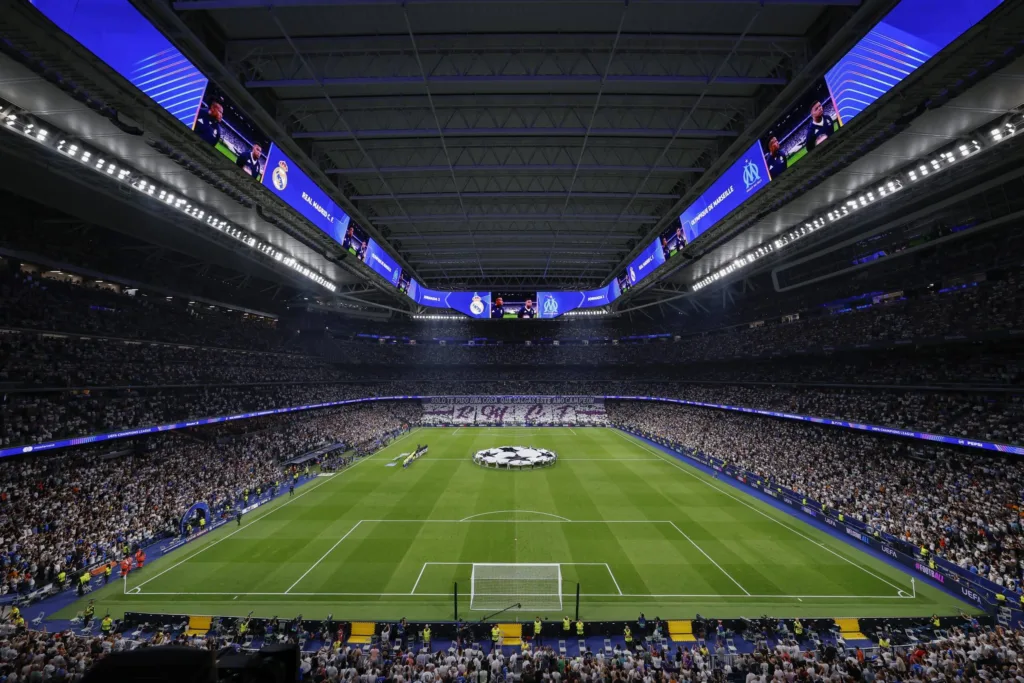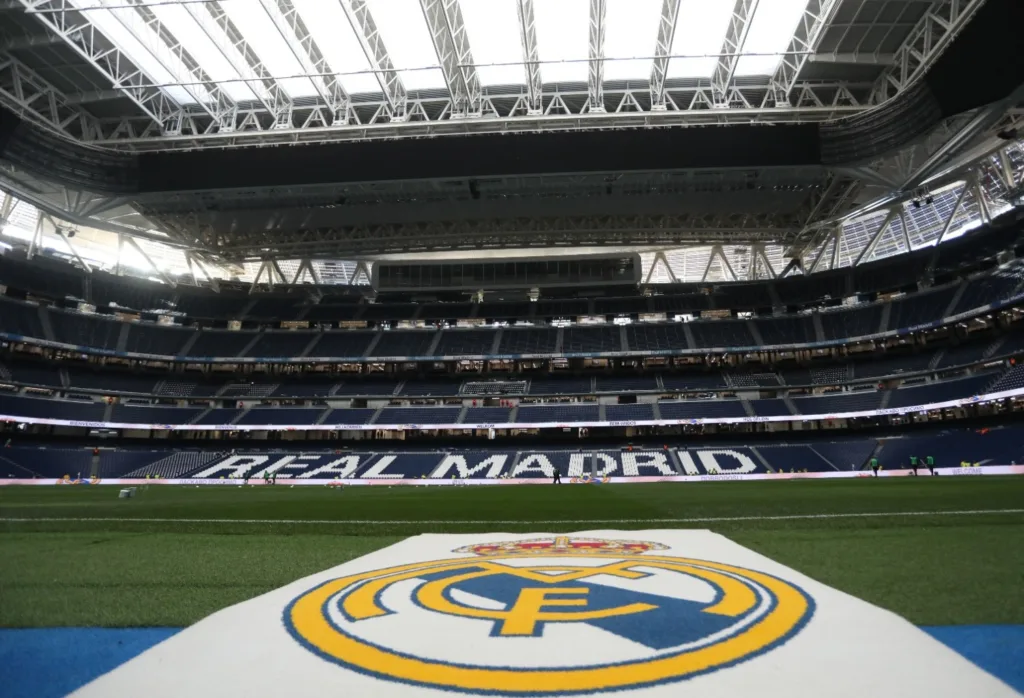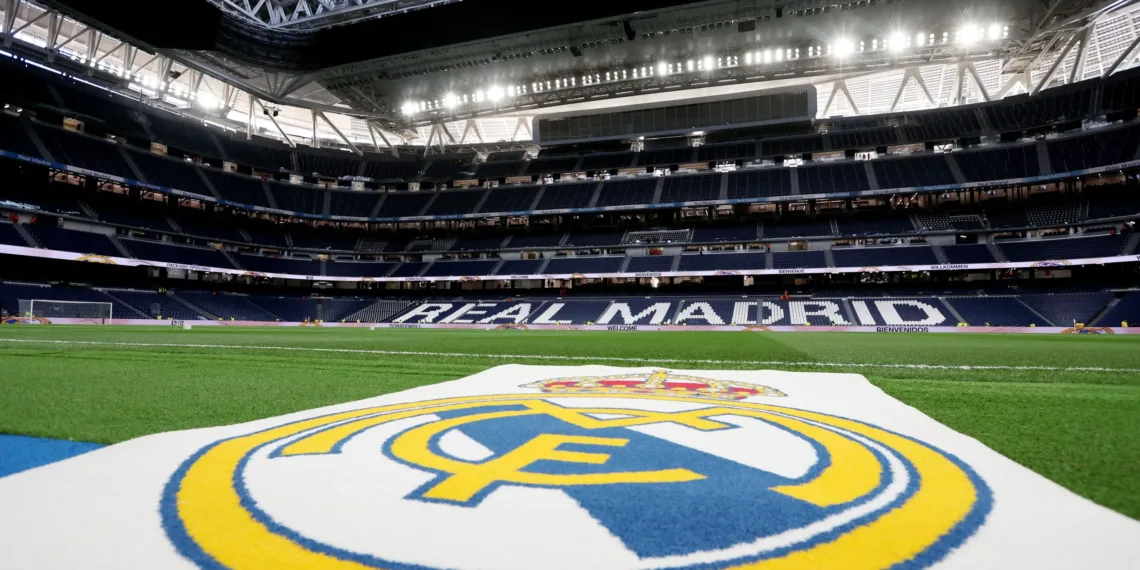Real Madrid has officially renamed its iconic stadium from “Estadio de Santiago Bernabéu” to simply “Bernabéu,” marking the first significant name change since 1955. The Spanish giants unveiled a sleek new logo and streamlined brand identity designed to enhance global appeal and unlock commercial opportunities, with the rebrand debuting during Spain’s first NFL game on November 16, 2025, between the Washington Commanders and Miami Dolphins.
Table of Contents
The Name That Echoes Through Football History
Since January 1955, the stadium has carried the full designation “Estadio de Santiago Bernabéu,” honoring the club’s legendary president and former player who transformed Real Madrid into a global powerhouse. Santiago Bernabéu, who led the club from 1943 until his death in 1978, oversaw the construction of the stadium and guided the team through their golden era of European dominance.

Now, Real Madrid has streamlined this heritage into a single, powerful word: Bernabéu. The shortened name maintains the essence of the club’s identity while offering what officials describe as a “more impactful” brand that’s easier to pronounce internationally and more commercially viable in the global marketplace.
| Stadium Evolution Timeline |
|---|
| 1947 – Original stadium opens as Nuevo Estadio Chamartín |
| 1955 – Renamed Santiago Bernabéu after club president |
| 2019 – Major renovation project begins |
| 2024 – Renovation completed with retractable roof |
| 2025 – Rebranded as “Bernabéu” with new corporate identity |
The new logo features the sleek, futuristic profile of the renovated stadium’s exterior—a fitting visual metaphor for Real Madrid’s ambitious transformation. This fresh branding made its public debut during promotional materials for the NFL International Series game between the Washington Commanders and Miami Dolphins, marking Spain’s first-ever professional American football match on November 16, 2025.
Strategic Modernization Beyond Football
Real Madrid’s rebranding strategy extends beyond nomenclature. The club has invested heavily in transforming the Bernabéu into a year-round entertainment complex capable of hosting diverse events that will generate revenue even when the football team isn’t playing.
The recently completed renovation, which cost over 256 million euros since initial investments in 2000, has equipped the stadium with state-of-the-art facilities including a retractable roof, expanded seating capacity, and cutting-edge technology. Perhaps most significantly for the club’s financial future, architect Josep Ribas confirmed that comprehensive soundproofing will be completed by 2026, enabling the venue to host concerts without disturbing neighboring residents—a previous source of controversy and legal challenges.
| New Revenue Streams at Bernabéu |
|---|
| Food market with diverse culinary options |
| Multiple premium bars and hospitality suites |
| Concert venue capabilities (soundproofing by 2026) |
| NFL and international sporting events |
| Mavidad Christmas festival (December 24-31) |
| Museum and stadium tour operations |
The venue’s commercial potential already shows promise. The upcoming Mavidad Christmas-themed festival, running from December 24-31, sold out completely within days of announcement, demonstrating strong public appetite for non-football events at the iconic location.
Commercial Considerations and Fan Reactions
While Real Madrid hasn’t officially announced plans for title sponsorship, industry observers note that simplifying the stadium name to “Bernabéu” creates opportunities for potential naming rights deals. Adding a corporate sponsor’s name could generate tens of millions in annual revenue—critical funding as the club competes financially with state-backed and privately-owned European rivals.
However, this commercial calculus has generated mixed reactions among Real Madrid’s socios (club members). Some fans view the change pragmatically, recognizing that most supporters already referred to the venue simply as “Bernabéu” in casual conversation. Others express concern that removing “Santiago” from prominent branding represents a profit-driven departure from tradition that diminishes the legacy of one of football’s most influential figures.

The debate intensified when eagle-eyed supporters noticed that “Santiago” had disappeared from the club’s official website, social media accounts, and merchandise in the club store—changes that preceded the formal announcement. When workers began installing new signage featuring only a large “B” on the stadium’s facade, they immediately covered it with a white sheet, fueling speculation and controversy among the fanbase.
Pérez’s Vision for Club Transformation
The stadium rebrand forms part of President Florentino Pérez’s broader initiative to modernize Real Madrid’s structure. At the upcoming General Assembly, Pérez is expected to unveil proposed reforms to the club’s member-owned governance model—a potentially controversial move that could reshape how one of football’s most storied institutions operates.
These organizational changes coincide with ongoing infrastructure projects around the stadium, including plans for an underground parking facility linked directly to the Bernabéu and renovations to the adjoining metro station. The parking project currently faces legal opposition from local residents, highlighting the complex relationship between the club’s ambitions and neighborhood concerns about noise, traffic, and quality of life.
Despite these challenges, Real Madrid remains committed to positioning the Bernabéu as a premier global destination. The stadium has already hosted Champions League finals, World Cup matches, papal addresses, and countless iconic musical performances. Now, with American football, Christmas festivals, and future concert series on the calendar, the venue is evolving into something unprecedented in European sports.
A Stadium That Transcends Sport
The Bernabéu’s historical significance extends beyond football achievements, though those remain extraordinary. The venue has witnessed four European Cup/Champions League finals and hosted both the 1982 World Cup final and the 1964 European Championship final—making it the first stadium in Europe to stage both tournaments’ championship matches.
In 2018, it made history again by hosting the Copa Libertadores final, becoming the only stadium worldwide to stage the finals of both European and South American club football’s premier competitions.
This rich heritage now serves as foundation rather than limitation. Real Madrid envisions the Bernabéu as a living, breathing entertainment complex that honors its past while embracing an ambitious, commercially viable future. The shortened name symbolizes this philosophy—respecting tradition through retention of “Bernabéu” while signaling openness to evolution through streamlined, modern branding.
As Los Blancos navigate this transformation, they’re attempting to balance competing demands: satisfying passionate socios who value history, generating revenue to compete with wealthier rivals, and maintaining the venue’s status as one of football’s cathedral-like destinations. Whether this delicate equilibrium can be sustained remains to be seen, but one thing is certain—the Bernabéu, in whatever form it takes, will continue defining what it means to be Real Madrid.

The stadium that Santiago Bernabéu built seven decades ago is entering uncharted territory, carrying his name forward into an era he could scarcely have imagined.
Read More: Endrick to Lyon: Brazilian Star’s January Loan Move Almost Done from Real Madrid
FAQs
Why did Real Madrid shorten the Santiago Bernabéu name?
Real Madrid simplified the stadium name to “Bernabéu” for commercial and marketing purposes, creating a more globally recognizable brand that’s easier to pronounce internationally while potentially opening opportunities for future sponsorship deals.
When was the stadium originally named Santiago Bernabéu?
The stadium was renamed Santiago Bernabéu on January 4, 1955, during a General Assembly of Members, honoring the club president who oversaw its construction and guided Real Madrid through its golden era of European success.
Will the stadium get a corporate sponsor name?
While Real Madrid hasn’t officially announced sponsorship plans, the simplified “Bernabéu” name could facilitate future naming rights deals that would generate significant annual revenue for the club, similar to other major European stadiums.
How have Real Madrid fans reacted to the name change?
How have Real Madrid fans reacted to the name change?
What new features does the renovated Bernabéu offer?
The renovated stadium includes a retractable roof, food market, premium hospitality areas, expanded seating, and soundproofing (completing in 2026) that will enable concert hosting, NFL games, and year-round entertainment events.








